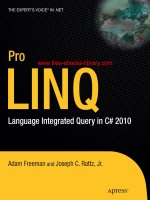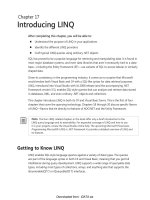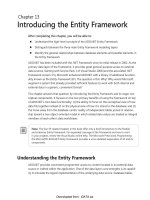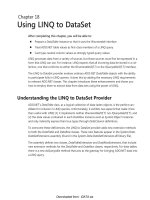Introducing LINQ
Bạn đang xem bản rút gọn của tài liệu. Xem và tải ngay bản đầy đủ của tài liệu tại đây (309.63 KB, 16 trang )
Chapter 17
Introducing LINQ
After completing this chapter, you will be able to:
Understand the purpose of LINQ in your applications
Identify the different LINQ providers
Craft typical LINQ queries using ordinary .NET objects
SQL has proved to be a popular language for retrieving and manipulating data. It is found in
most major database systems, and even data libraries that aren’t necessarily tied to a data-
base—including the Entity Framework (EF)—use variants of SQL to access tabular or similarly
shaped data.
Given its consistency in the programming industry, it comes as no surprise that Microsoft
would endow both Visual Basic and C# with a SQL-like syntax for data retrieval purposes.
LINQ, introduced into Visual Studio with its 2008 release (and the accompanying .NET
Framework version 3.5), enables SQL-style queries that can analyze and retrieve data stored
in databases, XML, and even ordinary .NET objects and collections.
This chapter introduces LINQ in both its C# and Visual Basic forms. This is the first of four
chapters that cover the querying technology. Chapters 18 through 20 discuss specific flavors
of LINQ—flavors that tie directly to features of ADO.NET and the Entity Framework.
Note
The four LINQ-related chapters in this book offer only a brief introduction to the
LINQ query language and its extensibility. For expanded coverage of LINQ and how to use
it in your projects, review the Visual Studio online help. The upcoming Microsoft Press book,
Programming Microsoft® LINQ in .NET Framework 4, provides a detailed overview of LINQ and
its features.
Getting to Know LINQ
LINQ enables SQL-style language queries against a variety of data types. The queries
are part of the language syntax in both C# and Visual Basic, meaning that you get full
IntelliSense during query development. LINQ supports a wide range of queryable data
types, including most types of collections, arrays, and anything else that supports the
IEnumerable(Of T) or IQueryable(Of T) interfaces.
Dwonloaded from: iDATA.ws
290
LINQ was a major enhancement to Microsoft’s .NET language offerings; it brought several
syntax additions to both Visual Basic and C#. To support these changes, it was necessary to
add many new technologies, all of which are now available even when you’re not using LINQ
in your applications. Some of the more significant technologies you might encounter when
using LINQ include the following:
Anonymous types Entity SQL used these nameless types to generate results that
didn’t tie to any predefined entity type or complex type. LINQ uses them for much the
same purpose, allowing your code to project queries that include property sets not tied
to any custom class defined in your source code.
Nullable types The .NET Framework has always supported nullable reference types,
allowing your code to assign a value of null (C#) or Nothing (Visual Basic) to, say, a
string instance variable. Nullable types extend this same support to value types, such as
System.Int32 and System.Bool. LINQ uses nullable types to represent fields that contain
missing values in query results.
Lambda expressions Lambdas are function definitions that enable lightweight, call-
able logic in an in-line experience. LINQ uses lambda expressions to define the specifics
of each query operation, among other tasks.
Extension methods These methods let you add functionality to an existing class def-
inition, even if you don’t have access to the class source code. Query builder methods,
discussed in Chapter 16, “Understanding Entities Through Objects,” are extension meth-
ods. In fact, those same query builder methods provide much of the core functionality
for LINQ.
Object initializers Object initializers provide a convenient way of setting the proper-
ties of a new object instance, all in a single source code statement. More important,
this action is considered “in line,” meaning that the resulting populated instance can be
used right away in the same statement. New instances of objects generated by a LINQ
query have their fields populated using this tool. A related feature known as collection
initializers provides similar functionality for arrays and collections of individual objects.
Local type inference This feature lets the language compiler identify the data type
of a variable on your behalf, all based on the type of content being assigned to the
variable. LINQ depends heavily on inference, but you’ll see it most clearly when assign-
ing the results of a query to an untyped variable.
Relaxed delegates The .NET Framework enforces strong typing, not only in primitive
data types but also in function delegates and signatures. But there is still room for va-
riety through the use of function overloads. Relaxed delegates provide a form of func-
tion overloading to event handlers and delegates, allowing code to trigger handlers
that don’t necessarily conform to the official definition. The individual operations that
make up a LINQ query use somewhat ad hoc handlers that are implemented through
relaxed delegates.
Dwonloaded from: iDATA.ws
Chapter 17 Introducing LINQ
291
Partial methods Partial methods allow classes (typically generated classes) to define
methods that might or might not be implemented at compile time. The inclusion of
these optional methods is left up to the programmer filling out the remainder of the
partial class definition. You can enhance your queries with partial methods to add inter-
active processing while the LINQ query builds the results.
XML literals, XML axis properties, and embedded XML expressions Version 3.5
of the .NET Framework added several new XML-related technologies, including the
somewhat exciting XML literals functionality included with Visual Basic. LINQ can query
XML content, and these technologies are used for such queries.
You can read about all these features in detail in the Visual Studio online help.
LINQ provides a common SQL-like experience to data retrieval within your source code. But
the syntax and features used change slightly depending on the type of data being queried.
LINQ includes several providers that tie to the type of data accessed by the system.
LINQ to Objects This is LINQ in its most basic form: the ability to query ordinary .NET
objects and collections. LINQ to Objects is the main focus of this chapter.
LINQ to DataSet ADO.NET DataSet instances have their own LINQ provider, enabling
specialized queries against the related tables and column values defined within each
set. Chapter 18, “Using LINQ to DataSet,” introduces this DataSet-centric form of LINQ.
LINQ to Entities This provider enables LINQ queries against an Entity Data Model,
whether generated by the EF’s Entity Data Model Designer or crafted by hand in XML.
An introduction to LINQ to Entities appears in Chapter 19, “Using LINQ to Entities.”
LINQ to SQL The LINQ to SQL provider specifically targets data stored in a Microsoft
SQL Server database. Information on the specifics of using this provider appears in
Chapter 20, “Using LINQ to SQL.”
LINQ to XML LINQ lets you query XML tags and attributes as if they were typical
database elements. The LINQ to XML provider is not discussed in this book.
LINQ is extensible, so third parties can develop their own providers. Several special-purpose
providers already exist, enabling access to formats as diverse as comma-separated values
(CSV) and Wikipedia.
Using LINQ with .NET Objects
The LINQ to Objects provider enables queries against standard .NET arrays, collections, ge-
neric collections, and anything else that implements the IEnumerable(Of T) or IQueryable(Of T)
interface. As in standard SQL, you form LINQ queries from operational clauses, such as Select,
Where, and Order By.
Dwonloaded from: iDATA.ws
292
Microsoft ADO.NET 4 Step by Step
Note
The capitalization and syntax of the clause keywords differ slightly between C# and Visual
Basic. For readability purposes, I will use the Visual Basic form of these keywords when referring
to them in the prose text, but all examples appear in both languages.
For the sample queries in this section, assume that the following two simple object collec-
tions, transport and speed (code shown as follows), already exist and are available to the
query code:
C#
var transport = new[] { new { Name = "Car", Wheels = 4, SpeedClass = 3 },
new { Name = "Motorcycle", Wheels = 2, SpeedClass = 3 },
new { Name = "Bike", Wheels = 2, SpeedClass = 2 },
new { Name = "Unicycle", Wheels = 1, SpeedClass = 1 },
new { Name = "Tricycle", Wheels = 3, SpeedClass = 1 },
new { Name = "Semi", Wheels = 18, SpeedClass = 3 }};
var speed = new[] { new { ClassID = 1, Name = "Low",
LowMaxSpeed = 1, HighMaxSpeed = 10 },
new { ClassID = 2, Name = "Medium",
LowMaxSpeed = 11, HighMaxSpeed = 50 },
new { ClassID = 3, Name = "High",
LowMaxSpeed = 51, HighMaxSpeed = 150 }};
Visual Basic
Dim transport = {New With {.Name = "Car", .Wheels = 4, .SpeedClass = 3},
New With {.Name = "Motorcycle", .Wheels = 2, .SpeedClass = 3},
New With {.Name = "Bike", .Wheels = 2, .SpeedClass = 2},
New With {.Name = "Unicycle", .Wheels = 1, .SpeedClass = 1},
New With {.Name = "Tricycle", .Wheels = 3, .SpeedClass = 1},
New With {.Name = "Semi", .Wheels = 18, .SpeedClass = 3}}
Dim speed = {New With {.ClassID = 1, .Name = "Low",
.LowMaxSpeed = 1, .HighMaxSpeed = 10},
New With {.ClassID = 2, .Name = "Medium",
.LowMaxSpeed = 11, .HighMaxSpeed = 50},
New With {.ClassID = 3, .Name = "High",
.LowMaxSpeed = 51, .HighMaxSpeed = 150}}
These collections are anonymous in that a formal class was not defined to hold each instance.
Instead, C# and Visual Basic defined ad hoc (anonymous) classes based on the With clause in
each new object instance.
LINQ’s core implementation appears in the System.Linq namespace.
Dwonloaded from: iDATA.ws
Chapter 17 Introducing LINQ
293
Starting a Query with the
From
Clause
The starting point for most LINQ queries is the From keyword. It serves much the same pur-
pose as the FROM keyword in SQL, but andunlike the SQL variant, the LINQ From keyword
appears first in typical query statements.
C#
// ----- Standalone From clauses are not supported in C#.
// This next line will not compile, but serves only
// to demonstrate the general syntax.
var results = from tr in transport;
Visual Basic
Dim results = From tr In transport
The From clause identifies the enumerable source of the query (transport in this case) and its
single-instance operator (tr), also known as a range variable. It’s akin to working with a collec-
tion of entities in the Entity Framework, where an individual entity is something distinct from
the collection that contains it.
Your query need not be limited to anonymous results, either. If you know the data type of
the query output, you should take advantage of this knowledge by using a target variable of
the expected type.
C#
// ----- Standalone From clauses are not supported in C#.
// This next line will not compile, but serves only
// to demonstrate the general syntax.
IEnumerable<Customer> results = from cu in Customers;
Visual Basic
Dim results As IEnumerable(Of Customer) = From cu In Customers
The single-line From query is the simplest LINQ query you can form in Visual Basic (it is
not supported in C#), and it doesn’t do much more than express the source collection as
IEnumerable(Of T).
Projecting Results with the
Select
Clause
The Select keyword lets you create a projection, a transformation of the original columns or
properties into a new subset of columns or properties. The output properties can include any
of the source properties and can also include static values or calculated values.
Dwonloaded from: iDATA.ws
294
Microsoft ADO.NET 4 Step by Step
The following statement projects four new properties from the original speed collection: a
calculated string value, two of the original numeric properties, and a new property that in-
volves a complex multiproperty calculation. When including multiple output properties in your
projection, C# requires that the properties be contained in a new anonymous type definition
(new {}). Visual Basic lets you retain a more SQL-like presentation, allowing you to list the
fields without the object-creation syntax.
C#
var results = from sp in speed
select new { Name = sp.Name.ToUpper(), sp.LowMaxSpeed, sp.HighMaxSpeed,
SpeedRange = (sp.HighMaxSpeed - sp.LowMaxSpeed + 1) };
Visual Basic
Dim results = From sp In speed
Select Name = sp.Name.ToUpper, sp.LowMaxSpeed, sp.HighMaxSpeed,
SpeedRange = (sp.HighMaxSpeed - sp.LowMaxSpeed + 1)
This query is a little more interesting than a plain From clause. And it’s interesting-looking
as well because it gives the impression of a SQL-like query within the very syntax of the C#
or Visual Basic source code. Behind the scenes, the language is coercing these queries into a
typical method-based format so that it can be turned into standard .NET compiled code. If
desired, you can skip the SQL-style coding and craft the method-style statements yourself.
The following statement replicates the functionality of the SQL-style statement appearing
just above.
C#
var results = speed.Select(sp => new { Name = sp.Name.ToUpper(),
sp.LowMaxSpeed, sp.HighMaxSpeed,
SpeedRange = sp.HighMaxSpeed - sp.LowMaxSpeed + 1 });
Visual Basic
Dim results = speed.Select(Function(sp) New With {
.Name = sp.Name.ToUpper, sp.LowMaxSpeed, sp.HighMaxSpeed,
.SpeedRange = sp.HighMaxSpeed - sp.LowMaxSpeed + 1})
Instead of the database-style query format, this version works directly with the extension
methods and lambda expressions that form the basis of LINQ query processing.
Unless you specify otherwise, the output of a projection will be a new anonymous type. To
force output of a specific type, include the type name when building the projection fields.
Dwonloaded from: iDATA.ws









